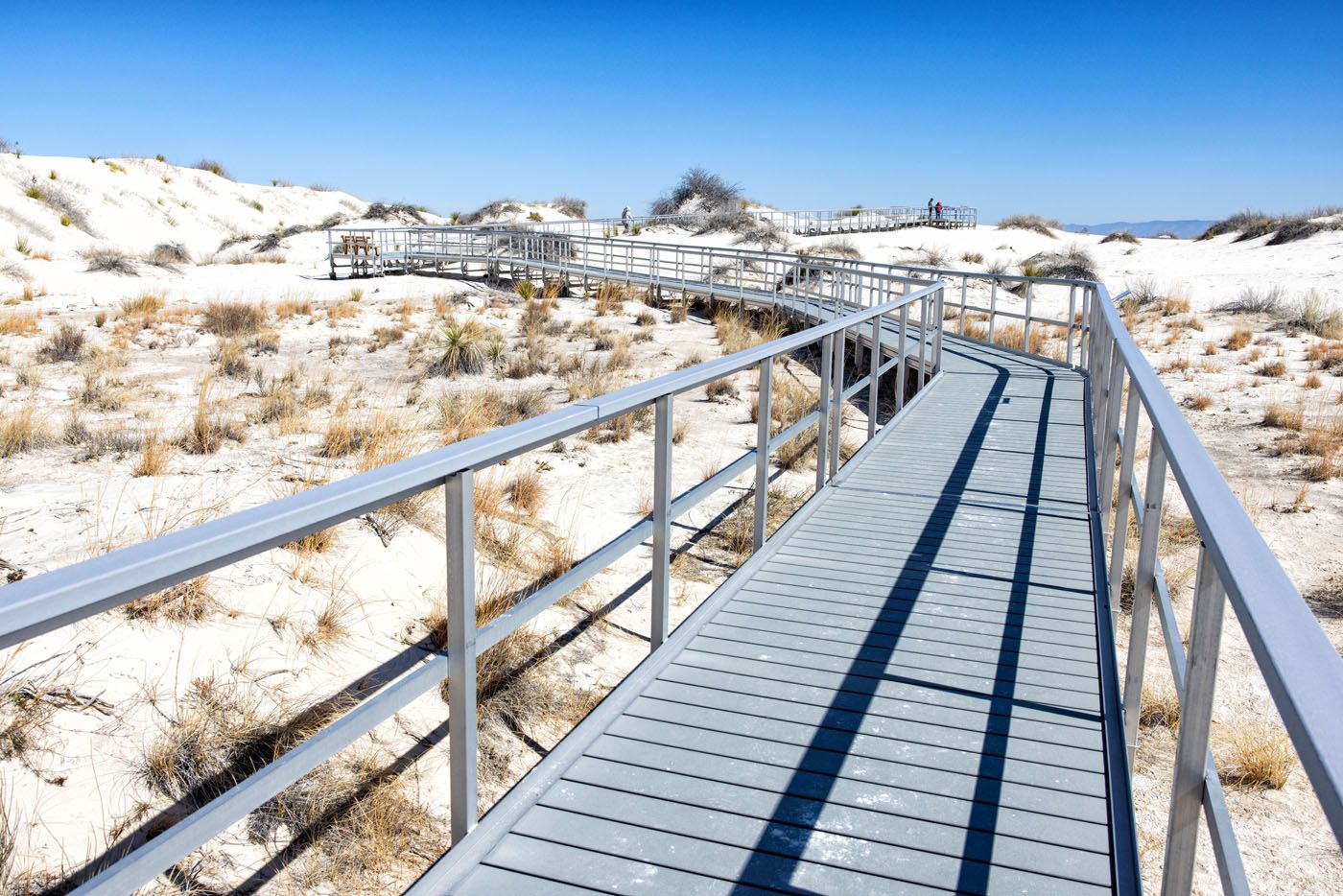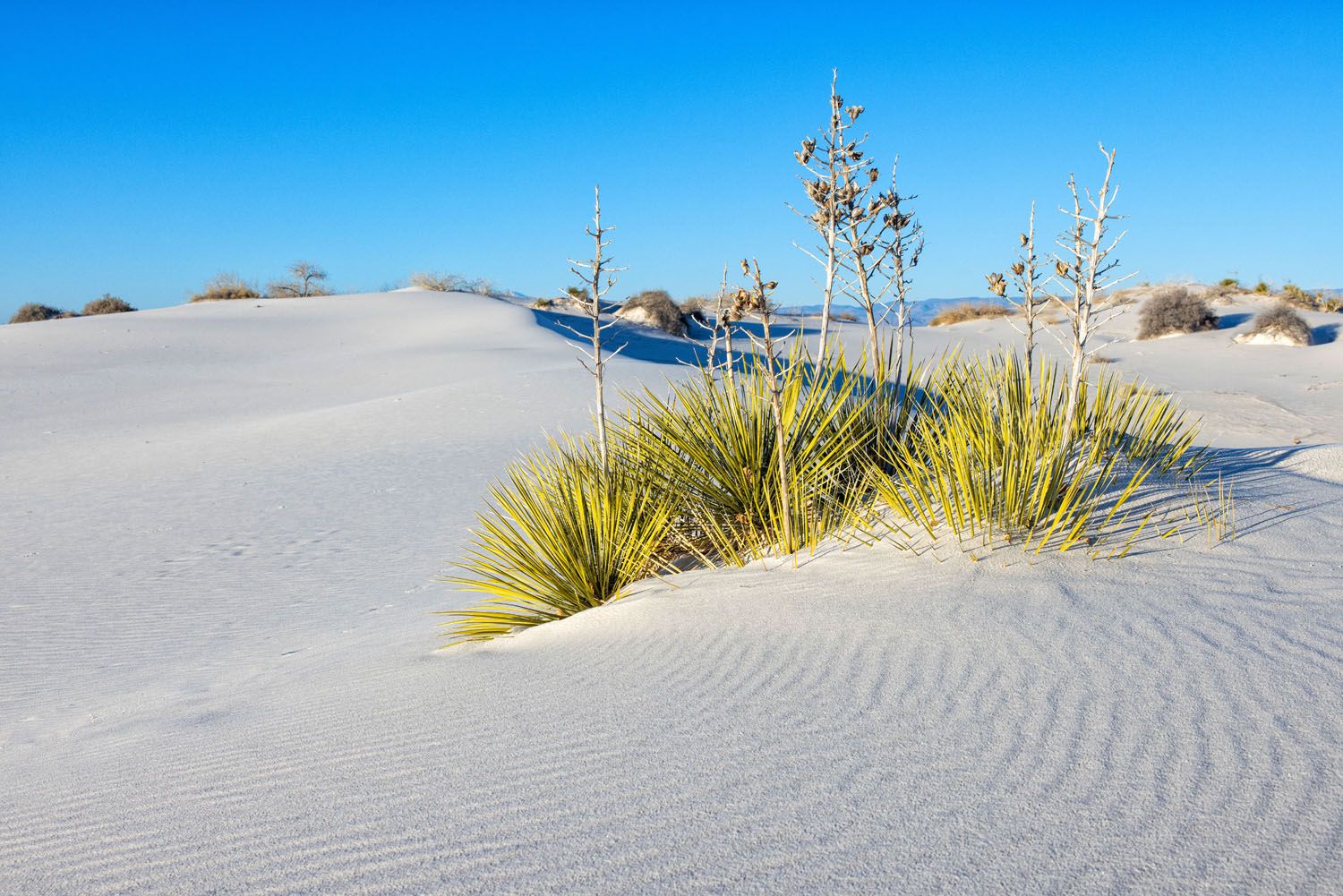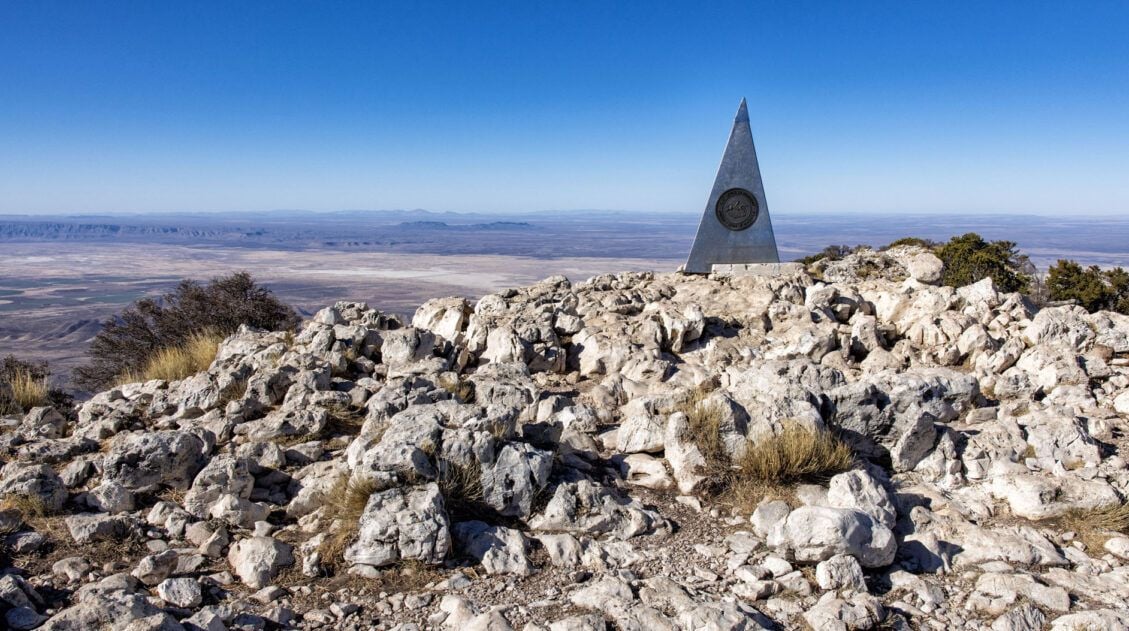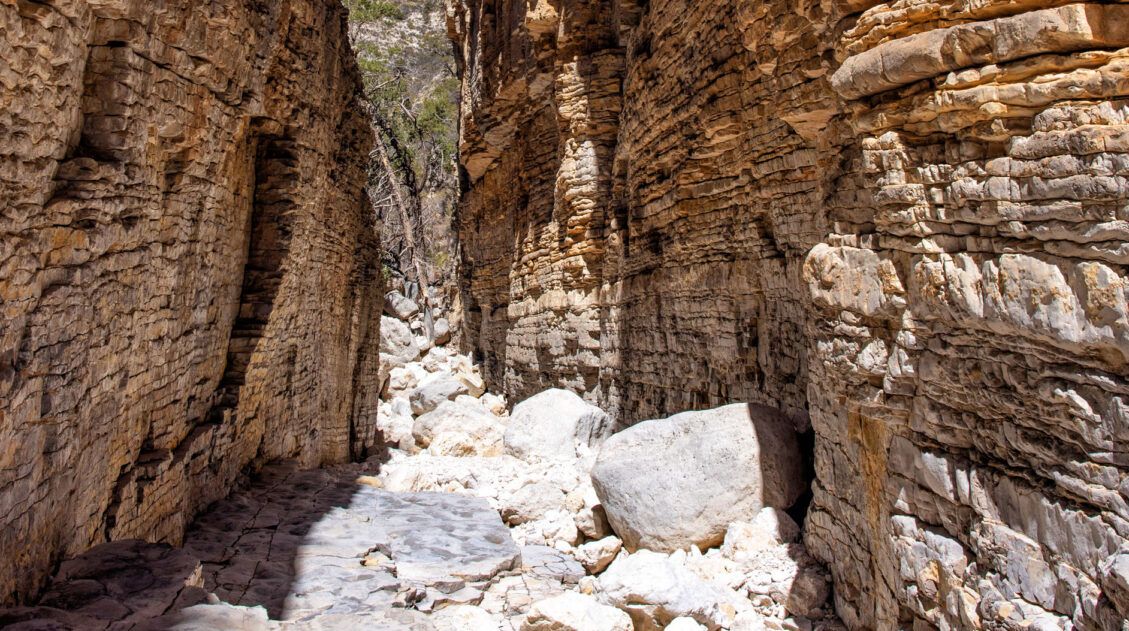White Sands National Park is home to the largest gypsum dunefield in the world. These pure white dunes create a fun place to explore, for both kids and adults. Hike out into the dunes, learn about the wildlife that calls this park home, and go sledding on sand as white as the snow…these are just a few wonderful things you can do in White Sands National Park.
In this guide, we cover how to visit White Sands National Park, from the best things to do, to how to plan your time, and when to visit. Since this park is entirely located within the White Sands Missile Range, there are some important things you should know as you plan your trip and we cover those, too.
Please practice the seven principles of Leave No Trace: plan ahead, stay on the trail, pack out what you bring to the hiking trail, leave areas as you found them, minimize campfire impacts, be considerate of other hikers, and do not approach or feed wildlife.
Interesting Facts about White Sand Dunes National Park & Missile Range
White Sands National Park is in New Mexico and it is located entirely within the White Sands Missile Range.
The White Sands Missile Range is a military testing ground that was established in 1945. On July 16, 1945, the first atomic bomb was detonated at the Trinity Site, which is on the far northern end of the White Sands Missile Range, miles away from the national park. Twice a year, you can take a ranger guided tour of this site.
The White Sands Missile Range was also used as an emergency landing site for the Space Shuttle. The white gypsum sand dunes can easily be seen from space, and in 1982, the Space Shuttle Columbia landed here.
White Sands National Park preserves and protects a large portion of the Tularosa Basin. This area includes the dunes and an abundance of wildlife.
The white sand dunes are made of gypsum crystals. Over the last 12,000 years, rainwater dissolved the gypsum in the surrounding mountains and deposited the gypsum in the Tularosa Basin, forming these sand dunes.
WHAT IS GYPSUM? Gypsum is a soft sulfate mineral compound that is composed of calcium sulfate dihydrate. Since it is water soluble, gypsum usually does not occur in the form of sand. However, the unique conditions at White Sands National Park (hot, dry weather) have helped create the large expanse of gypsum sand dunes seen here. Gypsum is mined at sites around the world and it is used in drywall, fertilizer, plaster, shampoo, and even “silken tofu.”
Very recently, the oldest known human footprints in North America were discovered in White Sands National Park. These footprints date back to 23,000 years ago, which puts humans in North America during the Last Glacial Maximum.
White Sands officially became a national park on December 20, 2019. In 2023, 730,000 people visited the national park.
Best Things to Do in White Sands National Park
Here is a list of the best things to do in White Sands National Park. At the end of this list, you can see all of them on a map.
1. Dunes Drive: Go on a Scenic Drive
There is only one road in White Sands National Park and that road is Dunes Drive.

Dunes Drive
This road is 8 miles long, one-way. It runs from the park entrance into the heart of the dunefield. Along this road are trailheads, picnic areas, and sledding spots.
Most of the road is paved but the last 3 miles is a hard-packed gypsum sand road. It looks like the road is snow-covered but nope, that’s just sand. There may be some washboarding on this section of road, but it is suitable for standard vehicles, motorcycles, RV’s and bicycles.
If you drive from the park entrance to the end of Dunes Drive, it takes 15 to 20 minutes. But most likely, you will stop at least once or twice along the way, either for photos or to visit the other items on this to-do list.

Picnic Area on Dunes Drive
2. Stop By the Visitor Center
The Visitor Center is located at the intersection of Dunes Drive and Highway 70. This is a good place to go to the bathroom, go shopping in the gift shop, talk to a park ranger about park conditions, or grab a bite to eat (there is a small concession stand here).
This is also the place to purchase a sled, if you plan to sled on the dunes. Sleds cost $24.99 and wax (highly recommended!) costs $2.99. If you return your sled when you are finished with it, you get a “free” koozie. I don’t know for sure, but I think the used sleds are re-sold. I hope so, to cut down on plastic waste.
3. Walk the Playa Trail
Distance: 0.4 miles out-and-back | Difficulty: Easy | Total Ascent: Minimal | Time: 15 to 30 minutes

Playa Trail
The Playa Trail was our least favorite hike in the park, but I’m mentioning it, just so you know about it.
It’s a short hike and there are a few signs along this flat, sandy trail that explains the geology and natural history of the park.
This trail is not located in the heart of the beautiful white sand dunes (those are just a little farther up the road), but if you want to learn more about the natural history of this area, then this short walk is worth the time.
But there are four other hikes/strolls that we recommend over the Playa Trail.
4. Dune Life Nature Trail
Distance: 1.1 mile loop | Difficulty: Easy | Total Ascent: 120 feet | Time: 30 to 60 minutes
If you want to hike on the dunes but not go too far, this is a trail to consider. The Dunes Life Nature Trail is located right where the “good” dunes start.
On this nature trail, you will get to hike up and over the white sandy dunes. There is more plant life here than in the heart of the park, which gives this trail the name “Nature Trail.” Along the loop, numerous signs teach you about the plants and animals that thrive in this basin.

Trail signs on the Dune Life Nature Trail

Dune Life Nature Trail

View from the Dune Life Nature Trail

Dune Life Nature Trail
5. Interdune Boardwalk Trail
Distance: 0.4 miles out-and-back | Difficulty: Easy | Total Ascent: Minimal | Time: 15 to 30 minutes
This entire trail is an elevated boardwalk that leads out to a viewpoint of the dunefield and the Sacramento Mountains off in the distance. Like the Dune Life Nature Trail, there are a few signs here with information about the plants you will see next to the trail.

Interdune Boardwalk Trail

Interdune Boardwalk Trail
6. Alkali Flat Trail
Distance: 4.5 mile loop | Total Ascent: 700 feet | Difficulty: Strenuous | Time: 2 to 3 hours
Hiking the Alkali Flat Trail is one of the best things to do in White Sands National Park. In fact, it was our favorite experience (the Backcountry Trail was #2).

Alkali Flat Trail Elevation Profile
This is the longest, toughest hike in the park. It is a 4.5-mile loop through some of the largest dunes in White Sands. 4.5 miles may not sound like a lot, but hiking through sand is TOUGH. The dunes in White Sands aren’t huge, but you will hike up and down quite a few of them.
COMPARISON WITH GREAT SAND DUNES: If you have been to Great Sand Dunes National Park, then you know what you are in for. The dunes at Great Sand Dunes are enormous, reaching up to 750 feet tall. In White Sands, they are just a fraction of this. The tallest sand dunes in White Sands are 60 feet tall. But on the Alkali Flat Trail, you will hike up and over dozens of these dunes, and over 4.5 miles, it will add up.

Alkali Flat Trailhead

Alkali Flat Trail

View of the dunes from the trail

If you get started early enough, you can hike the trail without another person in sight. And it really doesn’t have to be all that early. We started this hike at 8 am.
This loop trail leads out to the Alkali Flat. You reach this point 2.25 miles into the hike, which is exactly the halfway point. Obey the National Park trail signs and do not leave the trail…there are unexploded ordnances in the Alkali Flat.

Alkali Flat
Once you reach the Alkali Flat, the trail turns back towards the parking lot. You can do this hike in either direction…we hiked it clockwise.

The view on the hike back to the parking lot.
PRO TRAVEL TIP: Winter is one of the best times to go hiking in White Sands National Park. Not only is the weather cooler, but the sand can freeze, making it much easier to hike on the dunes. We visited White Sands in early March. The day before our visit, it snowed, and when we did this hike, the morning low was in the high 20’s. We had soft sand if a few places, but for the most part, we walked on frozen, hard sand. When the temperatures are warmer, the sand is a lot “softer” and hiking is more challenging.
If you want sweeping views of the white sand dunes, this hike is absolutely worth the time and energy. We loved it, although by the end, it does start to get a little bit monotonous, as the views don’t change a whole lot. If the idea of hiking 4.5 miles on a tough, sandy trail doesn’t sound like your idea of fun, then we have one final hiking trail to recommend…the Backcountry Camping Trail.
7. Backcountry Camping Trail
Distance: 1.75 mile loop | Difficulty: Easy to moderate | Total Ascent: 200 feet | Time: 1 hour
The Backcountry Camping Trail is a shorter version of the Alkali Flat Trail. And don’t let the name fool you…you don’t have to camp or have a backcountry permit to do this hike. It gets its name because this trail leads to the backcountry campsites in this park.
Like the Alkali Flat Trail, this trail makes a loop through the snowy white sand dunes. The views are every bit as good as those you get on the Alkali Flat Trail, only you don’t have to go as far to get them.
This hike is perfect for those who want to hike out into the dunes without doing a long, strenuous hike.

Backcountry Trail


Backcountry Camping Trail
8. Go Backcountry Camping
This was not something that we did (backcountry camping was not offered during our visit) but it looks like an amazing experience.
There are 10 primitive backcountry campsites located within the dunefield. These are first-come, first-served and you need a permit to camp here.
All 10 sites are located along the Backcountry Camping Trail. Along this trailhead, each campsite is indicated with a tall, wooden post with the campsite number on it. These campsites are tucked away in the dunes and from what I could tell, are all relatively private.


Campsite #5
Currently, backcountry camping is not being offered since the campsites are undergoing rehabilitation. We spoke to a park ranger, and once backcountry camping becomes available again, the campsite schedule is released two weeks in advance. Backcountry camping is not permitted during planned missile testing, and this schedule is usually released to the NPS two weeks in advance. As for updates on when backcountry camping will be offered again, check the National Park Service website.
9. Go Sledding on the Dunes
Go sledding on sand dunes as white as the snow…this is one of the best things to do in White Sands National Park.
All you need is a basic plastic disc sled and you are good to go. Bring your own or purchase one from the gift shop at the Visitor Center. Note: The gift shop is open from 9 am to 5 pm (double check hours on the official NPS website), so if you get into the park before 9 am, you will have to do some backtracking to get back here to purchase your sled.
As of 2022, sleds cost $24.99 and wax costs $2.99. A park ranger we spoke to gave us this tip: wax the sled in “stripes” in the direction that you want to go, if you want to go fast. If you wax the board in a circular pattern, you won’t go as fast.
At the end of the day, return the sled to the gift shop and receive a “free” koozie.
Where to Go Sledding
Basically, you can pick any dune that you see. At the end of Dunes Drive, there are huge pull-outs right next to the dunes. These are popular sites to go sledding, since you don’t have to walk far into the dunes.
However, these spots can be crowded. If you want to get away from the crowds, head farther into the dunefield.

10. Take a Ranger-Guided Hike
There are several ranger-guided hikes at White Sands National Park.
Sunset Stroll
This is the most popular ranger-guided hike. On this short stroll, learn about the geology of the park and the plants and animals that live here. The stroll is timed to end at sunset. It lasts 45 minutes to one hour, it is free, and no reservation is required. Get tour times here.
Full Moon Hike
Hike on the dunes at sunset with a park ranger. This tour is offered once a month from April through October. There is an additional fee for this tour and you can purchase your ticket in advance. Get the full details here.
Lake Lucero Tour
Lake Lucero is the birthplace of the gypsum dunes. On this tour, learn how the white sands formed. This tour is offered once a month from November through March. There is an additional fee and you can purchase your ticket in advance. Get the full details here.
11. Photograph the Dunes
The white dunes, the plant life, and the backdrop of the San Andres Mountains and Sacramento Mountains makes this a beautiful park to photograph. If you want to take photos of untouched dunes, hike the Backcountry Campsite Trail or the Alkali Flat Trail. From both of these trails, you don’t have to walk far to see undisturbed dunes.

Alkali Flat Trail | Best Things to Do in White Sands National Park
Map of White Sands National Park
How to Use This Map: Click the icons on the map to get more information about each point of interest. To take this map with you, click the star next to the title of the map which adds it to your Google account. Next, within your Google Maps app, select ‘Saved’ and then select ‘Maps’. This map title will now appear in your list.
How Much Time Do You Need in White Sands National Park?
This park is small and easy to navigate. And with its short list of must-see sights, you don’t need to spend a whole lot of time here to really get to know this place.
In a half of day, you can hike one to two trails and do a little bit of sledding.
For the best experience, plan on spending one full day in White Sands National Park. Hike the Alkali Flat Trail first thing in the morning, before the crowds arrive and the temperatures climb. Midday, go sledding on the dunes and have a picnic lunch. You can also do one of the shorter hiking trails. At the end of the day, take the ranger-guided Sunset Stroll.
Best Time to Visit White Sands National Park
In general, fall, winter and spring are great times to visit White Sands National Park. Temperatures are mild and you avoid the scorching conditions that occur during the summer months.
Here is what to expect by season:
SPRING: Daytime high’s typically range from 70 degrees (in March) up to 90 degrees by the end of May. In March, the nights are cool and can get below freezing, but by May, the lows are in the 50’s. This is the driest time to visit the park (although rainfall remains relatively low all year).
SUMMER: Expect HOT weather. Average high’s hit 100°F and it is possible to see temperatures climb up to 110°F. This is also the wettest time to visit the park, but with rainfall totals only average 2 inches per month.
FALL: Daily highs and lows are very similar to springtime, but rainfall chances increase slightly.
WINTER: Daytime highs are usually in the high 50’s to low 60’s with below freezing temperatures at night. Snowfall is rare.
OUR VISIT IN MARCH: We visited White Sands on March 11 and 12, 2022. This was during an unusual cold front. The day before our visit, it rained/snowed and there was a light dusting of snow on some of the dunes. However, these cold temperatures froze the sand and made it a lot easier to hike on the dunes.
White Sands National Park appears in our Best US National Parks Month-By-Month series as a great park to visit in February, March, and November.

How to Get to White Sands National Park
White Sands National Park is located in southern New Mexico.
The closest airport is the El Paso International Airport. From here, it takes an hour and a half to drive to White Sands National Park.
Here are the driving distances and times from other nearby destinations:
- Albuquerque, New Mexico: 225 miles, 3.5 hours
- Roswell, New Mexico: 130 miles, 2.5 hours
- Carlsbad, New Mexico: 160 miles, 3 hours
- Guadalupe Mountains National Park: 190 miles, 3 hours
- Big Bend National Park: 425 miles, 7 hours
USA Road Trip with White Sands
If you are looking for a cool road trip idea, you can combine White Sands National Park with Carlsbad Caverns, Guadalupe Mountains, and Big Bend National Parks. Check out our 10-day Texas New Mexico Road Trip Itinerary for more information.
Where to Stay & Eat
Inside of the park, the only place to stay is are the primitive campgrounds in the gypsum dunefield.
Outside of the park, Alamogordo is the best place to stay. From this town, it takes 20 minutes to drive to the park entrance.
In Alamogordo, we stayed at the brand new Home2 Suites by Hilton and had a great experience. Other highly rated hotels include the Hampton Inn Alamogordo, the White Sands Motel, and the Fairfield Inn & Suites by Marriott.
Alamogordo has a bunch of chain restaurants like Chili’s, Buffalo Wild Wings, Applebee’s, IHOP, and Starbuck’s. We spent two nights in Alamogordo and both nights ate at D. H. Lescombe’s Winery and Bistro and highly recommend it (make a reservation in advance).
Things to Know Before You Go
Hours of Operation: Unlike many national parks, White Sands National Park has set hours of operation. This park is gated and once the gate is closed, you won’t be able to get in or out. The gate always opens at 7 am and closing time is adjusted seasonally (the closing time ranges from 6 pm to 9 pm depending on the time of year). Before your visit, check the hours of operation and make sure you exit the park before closing time.
Road Closures due to Missile Testing: Dunes Drive can close for up to 3 hours during missile testing at White Sands Missile Range. Usually, park staff is notified within 2 weeks of a missile testing, but in some instances, they may only get 24 hours notice. You can get updates on missile testing and road closures on the National Park Service website.
You May Not Have Cellular Service in the Park: When drone testing is being done at Holloman Air Force Base, cellular service and GPS is scrambled in the area. Be prepared for the possibility that you might not be able to access Google Maps, check the internet, call, or text.
Don’t Forget Your Sunglasses! On a sunny day, the white sand is highly reflective and almost blinding, just like being out in the snow. Sunglasses are a must at White Sands National Park.

Plan Your Visit
Park Entrance Fee: $25 per vehicle, valid for 7 days. There is also an annual White Sands Park Pass that costs $45. If you plan to visit White Sands National Park along with other national parks, consider buying the America the Beautiful Pass ($80 and valid for all of the national parks for one year).
Hours of Operation: This park is gated and once the gate is closed, you won’t be able to get in or out. The gate always opens at 7 am and closing time is adjusted seasonally (the closing time ranges from 6 pm to 9 pm depending on the time of year). Before your visit, check the hours of operation and make sure you exit the park before closing time.
Cellular Service: We had cellular service while in the park (we use Verizon). As stated above, during drone testing at Holloman Air Force Base, cellular and GPS signals can be scrambled so you will not have cellular service during this time.
Pets: Pets are allowed in the park as long as they are on a leash no longer than 6 feet. Please clean up after your pet and do not leave them unattended in vehicles. Pets are not allowed inside of the visitor center.
Get updates on road conditions and trail closures, as you plan your trip and just before your visit, on the National Park Service website.
If you have any questions about the best things to do in White Sands National Park or how to plan a trip to White Sands National Park, let us know in the comment section below.
Where Are You Going Next?
If your visit is part of a bigger road trip through New Mexico and Texas, here is more information to help you plan your trip:

















Comments 12